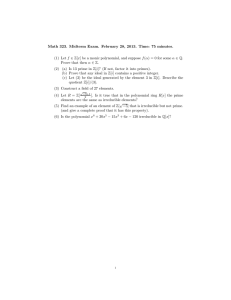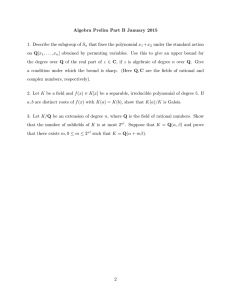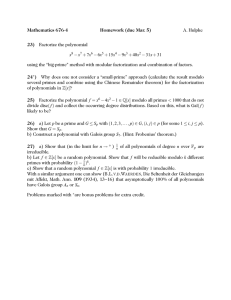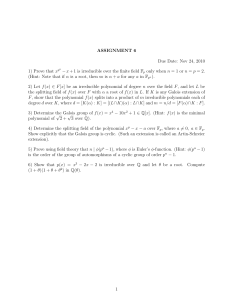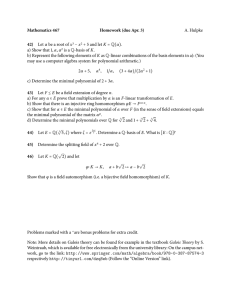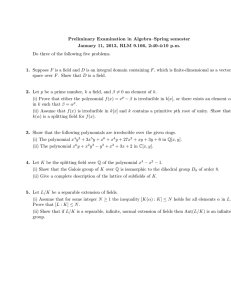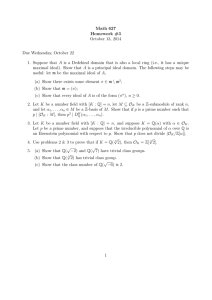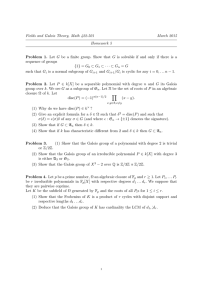ALGEBRAIC PROPERTIES OF KANEKO-ZAGIER LIFTS OF SUPERSINGULAR POLYNOMIALS
advertisement
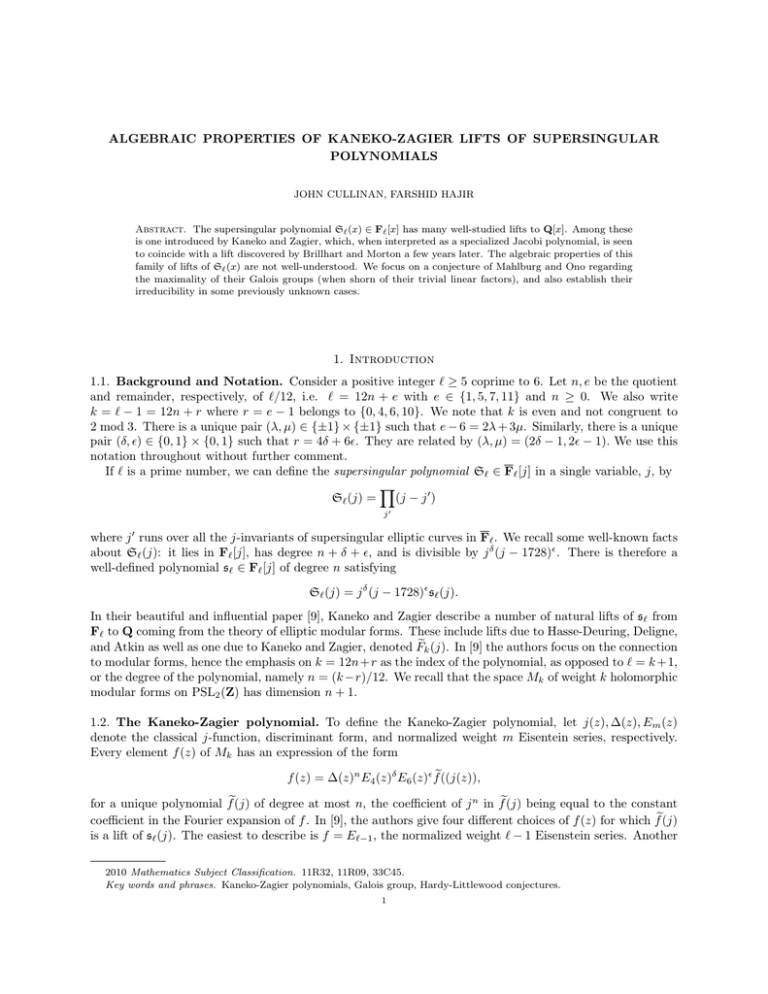
ALGEBRAIC PROPERTIES OF KANEKO-ZAGIER LIFTS OF SUPERSINGULAR
POLYNOMIALS
JOHN CULLINAN, FARSHID HAJIR
Abstract. The supersingular polynomial S` (x) ∈ F` [x] has many well-studied lifts to Q[x]. Among these
is one introduced by Kaneko and Zagier, which, when interpreted as a specialized Jacobi polynomial, is seen
to coincide with a lift discovered by Brillhart and Morton a few years later. The algebraic properties of this
family of lifts of S` (x) are not well-understood. We focus on a conjecture of Mahlburg and Ono regarding
the maximality of their Galois groups (when shorn of their trivial linear factors), and also establish their
irreducibility in some previously unknown cases.
1. Introduction
1.1. Background and Notation. Consider a positive integer ` ≥ 5 coprime to 6. Let n, e be the quotient
and remainder, respectively, of `/12, i.e. ` = 12n + e with e ∈ {1, 5, 7, 11} and n ≥ 0. We also write
k = ` − 1 = 12n + r where r = e − 1 belongs to {0, 4, 6, 10}. We note that k is even and not congruent to
2 mod 3. There is a unique pair (λ, µ) ∈ {±1} × {±1} such that e − 6 = 2λ + 3µ. Similarly, there is a unique
pair (δ, ) ∈ {0, 1} × {0, 1} such that r = 4δ + 6. They are related by (λ, µ) = (2δ − 1, 2 − 1). We use this
notation throughout without further comment.
If ` is a prime number, we can define the supersingular polynomial S` ∈ F` [j] in a single variable, j, by
Y
S` (j) =
(j − j 0 )
j0
where j 0 runs over all the j-invariants of supersingular elliptic curves in F` . We recall some well-known facts
about S` (j): it lies in F` [j], has degree n + δ + , and is divisible by j δ (j − 1728) . There is therefore a
well-defined polynomial s` ∈ F` [j] of degree n satisfying
S` (j) = j δ (j − 1728) s` (j).
In their beautiful and influential paper [9], Kaneko and Zagier describe a number of natural lifts of s` from
F` to Q coming from the theory of elliptic modular forms. These include lifts due to Hasse-Deuring, Deligne,
and Atkin as well as one due to Kaneko and Zagier, denoted Fek (j). In [9] the authors focus on the connection
to modular forms, hence the emphasis on k = 12n+r as the index of the polynomial, as opposed to ` = k +1,
or the degree of the polynomial, namely n = (k −r)/12. We recall that the space Mk of weight k holomorphic
modular forms on PSL2 (Z) has dimension n + 1.
1.2. The Kaneko-Zagier polynomial. To define the Kaneko-Zagier polynomial, let j(z), ∆(z), Em (z)
denote the classical j-function, discriminant form, and normalized weight m Eisentein series, respectively.
Every element f (z) of Mk has an expression of the form
f (z) = ∆(z)n E4 (z)δ E6 (z) fe((j(z)),
for a unique polynomial fe(j) of degree at most n, the coefficient of j n in fe(j) being equal to the constant
coefficient in the Fourier expansion of f . In [9], the authors give four different choices of f (z) for which fe(j)
is a lift of s` (j). The easiest to describe is f = E`−1 , the normalized weight ` − 1 Eisenstein series. Another
2010 Mathematics Subject Classification. 11R32, 11R09, 33C45.
Key words and phrases. Kaneko-Zagier polynomials, Galois group, Hardy-Littlewood conjectures.
1
choice due to Kaneko-Zagier, which will be our focus here, is for a certain modular form Fk we now describe.
Let θk be the differential operator on Mk defined by
θk f (z) = q
k
d
f (z) − E2 (z)f (z),
dq
12
where, as usual, q = e2πiz and E2 = ∆0 /∆. There is a unique normalized form Fk (z) ∈ Mk satisfying
k(k + 2)
E4 (z)Fk (z) = 0.
144
As we will see shortly, the corresponding Kaneko-Zagier polynomial Fek (j) lies in Q[j] and has degree n. It
e`−1 (j) have `-integral coefficients and satisfy
is shown in [9] that, when ` is prime, Fe`−1 (j) and E
θk+2 θk Fk (z) −
e`−1 (j) ≡ Fe`−1 (j) ≡ s` (j)
E
mod `.
As we will see in §2, the second congruence was independently derived by Brillhart and Morton [1].
1.3. Algebraic Properties. The study of algebraic properties of Fek (j) was initiated by Mahlburg and Ono
in [10], in which they put forward the following conjecture (in analogy with a similar expectation for the lift
e`−1 (j) of s` (j)).
E
Conjecture 1.4 (Mahlburg-Ono). With notation as in the opening paragraph, for each ` ≥ 5 coprime to 6,
the Kaneko-Zagier polynomial Fe`−1 (j) is irreducible and has Galois group Sn over Q.
Mahlburg and Ono give several infinite families of integers k for which Fek is irreducible and they also
check for most of those particular families that the discriminant is not a square. We extend their results
here in several directions. The main results of this paper can be summarized as follows.
Theorem 1.5. For ` ≥ 5 coprime to 6, the discriminant of Fe`−1 (x) is not a square in Q.
Theorem 1.6. Suppose Fe`−1 (x) is irreducible over Q. If ` can be expressed as ` = p + 6q where p and q
are primes and n/2 < q < n − 2, then the Galois group of Fe`−1 (x) is Sn .
Remark 1.7. As we will explain later, according to standard conjectures in analytic number theory about
the distribution of primes, every large enough integer ` coprime to 6 is expected to have one (and indeed
many) expressions as p + 6q with the q in the specified range. Thus, Theorem 1.6 reduces the Mahlburg-Ono
conjecture to expected properties of prime distributions. Though the latter are far out of reach at present,
Theorem 1.6 does nevertheless provide a highly effective and speedy numerical criterion for checking the
Mahlburg-Ono conjecture for any given `: namely, starting with the smallest prime exceeding n/2 and going
up, we look for a prime q such that ` − 6q is also prime. Any such pair, together with a verification of the
irreducibility of Fe`−1 (x), constitutes a “certificate” that this polynomial has Galois group Sn . This method
allows us to verify the “Galois part” of the Mahlburg-Ono conjecture for ` up to a billion.
Theorem 1.8. For ` ≤ 109 coprime to 6, if Fe`−1 (x) is irreducible, then its Galois group is Sn .
While our focus is mostly on the Galois group in this paper, we do have the following result on irreducibility
of Kaneko-Zagier polynomials, which is a complement to Theorem 1.1 in Mahlburg-Ono [10].
Theorem 1.9. If ` is of one the forms 6 · 4ν + 1, 6 · 4ν − 5, 3 · 4ν + 5, or 3 · 4ν − 1, then Fe`−1 (x) is irreducible
over Q.
2. The Kaneko-Zagier Polynomial as a Specialized Jacobi Polynomial
2.1. Relation to the Brillhart-Morton polynomial. Our starting point is an explicit expression for
Fek (j) as a hypergeometric polynomial given by Kaneko and Zagier. To describe this explicit form, recall
that the 2 F1 Gauss hypergeometric function is defined by
∞
X
a b
(a)ν (b)ν xν
def
,
F
;
x
=
2 1
c
(c)ν ν!
ν=0
2
where (·)ν is the Pochhammer symbol, given by (a)ν = a(a − 1)(a − 2) . . . (a − ν + 1). Kaneko and Zagier [9]
show (in their Theorem 5.ii applied with the involution σ that swaps 0 and ∞) that
−n n + e/6 j
n n + λ/3
e
,
(1)
Fk (j) = 1728
× 2 F1
;
1728
n
1 + λ/3
where we recall the notation is as in the opening paragraph of the introduction. As was pointed out by
Kaneko and Zagier, see the last paragraph of §8 in [9], the expression (1) essentially identifies Fek (x) as a
Jacobi Polynomial. To make this explicit, we recall that the Jacobi Polynomial with characteristics (α, β)
can be defined as the following hypergeometric polynomial:
−n 1 + α + β + n 1 − x
(α + 1)n
F
;
,
(2)
Pn(α,β) (x) =
2 1
1+α
n!
2
see [13]. With the choice (α, β) = (λ/3, µ/2), we find 1 + α + β = e/6 and setting x = 1 − j/864 in (2), (1)
simplifies to become
j
.
(3)
Fek (j) = 1728n Pn(λ/3,µ/2) 1 −
864
We should point out that the right hand side of (3) is precisely the polynomial denoted J` (j) in [1]; thus,
the Brillhart-Morton polynomial J` actually coincides with the Kaneko-Zagier polynomial Fe`−1 . Brillhart
and Morton (see [1, Theorem 3]) give an independent proof that J` (j) is a lift of s` (j).
2.2. Shifted Jacobi Polynomials. For convenience we switch from the variable j to the more conventional
(α,β)
(x) shows that when expanded in powers of (1 − x), the
x for our polynomials. The expression (2) for Pn
coefficients of this polynomial are explicit and highly factored. It is remarkable that the same is true for its
coefficients in powers of x. Indeed, if we define
def
Jn(α,β) (x) = Pn(α,β) (2x + 1),
we have the nice expansion, [13]
Jn(α,β) (x)
n X
n+α n+α+β+j j
=
x .
n−j
j
j=0
This same shift was useful (for Jacobi polynomials with characteristics (α, β) = (±1/2, 0)) for studying the
algebraic properties of Legendre polynomials in [4].
Definition 2.3. For any integer ` ≥ 5 coprime to 6, if we write ` = 12n + 3µ + 2λ + 6 where n ≥ 0 and
λ, µ ∈ {±1}, we define
j
n
n Y
Y
X
n
def
(λ + 3k)
(6n + 3µ + 2λ + 6k) xj .
K` (x) = Kn(λ,µ) (x) = 3n n!Jn(λ/3,µ/2) (2x) =
j
j=0
k=j+1
k=1
We can now state the expression of Fek (x) in terms of the polynomial we have just introduced.
Lemma 2.4. For any integer ` ≥ 5 coprime to 6, if we write ` = 12n+3µ+2λ+6 where n ≥ 0, λ, µ ∈ {±1},
we have
576n
−x
Fe`−1 (x) =
K`
.
n!
2 × 1728
In particular, K` (x) and the Kaneko-Zagier polynomial Fe`−1 (x) share the same irreducibility and Galois
properties.
(αβ)
Proof. The formula follows immediately from (3) and the definitions of Pn
(α,β)
(x), Jn
(x) and K` (x).
In light of Lemma 2.4, the factorization and Galois properties of the Kaneko-Zagier polynomial Fe`−1 (x)
exactly mirror those of the polynomial K` (x), and from now on we will work with K` (x) instead. The
rationale for introducing K` (x) is that it has been scaled to have coefficients in Z, making it a bit easier to
compute its Newton Polygons at well-chosen primes. The shape of those Newton Polygons can then be used
to prove algebraic facts about K` (x).
3
The layout of the paper is as follows. First, we give a criterion for an arbitrary specialization of the
(α,β)
Jacobi polynomial Pn
(x) to have a non-square discriminant and then show that this criterion applies to
(λ,µ)
Kn (x) for all n, λ, µ. We then move on to an investigation of the Newton Polygons of the K` (x) at large
primes. The idea is that if we have a decomposition ` = 12n + e = p + 6q, where p is a prime and 1 ≤ q ≤ n,
then the p-adic Newton polygon of K` (x) will have a slope 1/q segment. The Galois group of this polynomial
will then have a q-cycle; if q > n/2, a theorem of Jordan will then imply that the Galois group contains An ,
hence is Sn by our result on the discriminant. Finally, we conclude with some new cases of irreducibility of
the K` (x) in the final section.
3. Discriminant Formulæ
In this section we prove a general result on the discriminants of Jacobi polynomials and then employ
(λ,µ)
similar techniques as in [5] to show that for all n and all choices of λ and µ, the discriminant of Kn (x) is
not a rational square. Fix α, β ∈ Q and recall
j
n X
n+α n+α+β+j
x−1
(α,β)
,
Pn
(x) =
2
n−j
j
j=0
(α,β)
def
(α,β)
(2x + 1). It is well-known [13, thm. 6.71] that the
(x) = Pn
which was our motivation for defining Jn
discriminant of the Jacobi polynomial is given by
n
Y
(4)
disc Pn(α,β) (x) = 2−n(n−1)
k k−2n+2 (k + α)k−1 (k + β)k−1 (k + n + α + β)n−k .
k=1
Moreover, the discriminant of a general polynomial of degree n satisfies the transformation laws:
n−1
(5)
disc(νf (κx + γ)) = ν 2 κn
disc(f (x)).
For parameters u, v, t, w with u and v non-zero, we define the following polynomial in Z[x]:
j
n
n Y
Y
X
n
def
n (t/u,w/v)
(t + uk)
(tv + uw + (k + n)uv)xj .
Jn (u, v, t, w; x) = n!u Jn
(vx) =
j
j=0
k=j+1
k=1
Note that for ` = 12n + 2λ + 3µ + 6, with λ, µ ∈ {±1}, we have K` (x) = Jn (3, 2, λ, µ; x).
Proposition 3.1. The discriminant of Jn (u, v, t, w; x) is given by the following formula:
n
Y
disc Jn (u, v, t, w; x) = un(n−1)
k k (uk + t)k−1 (vk + w)k−1 (uv(n + k) + vt + uw)n−k .
k=1
Proof. Since we already have a formula for the discriminant of Pn , we apply (5) a few times in order to relate
the discriminant of Jn to that of Pn , as follows:
disc Jn (u, v, t, w; x) = disc n!un Jn(t/u,w/v) (vx)
n−1
= (n!un )2 v n
disc Jn(t/u,w/v) (x)
n−1
= (n!un )2 v n
disc Pn(t/u,w/v) (2x + 1)
n−1
= (n!un )2 v n
disc Pn(t/u,w/v) (2x)
n−1 n(n−1)
= (n!un )2 v n
2
disc Pn(t/u,w/v) (x).
When we apply (4) to the last equation, several simplifications occur and we have:
n
n−1 Y
disc Jn (u, v, t, w; x) = (n!un )2 v n
k k−2n+2 (k + t/u)k−1 (k + w/v)k−1 (n + k + t/u + w/v)n−k
k=1
= un(n−1)
n
Y
k k (uk + t)k−1 (vk + w)k−1 (uv(n + k) + vt + uw)n−k ,
k=1
4
as claimed.
Proposition 3.2. Let u, v, t, w ∈ Z. Suppose u, v ≥ 2, gcd(uv, tv + uw) = 1, and uv + vt + uw is odd. Then
there exists N ∈ Z such that for all n ≥ N , disc Jn (u, v, t, w; x) is not a square in Q× .
Proof. Let us explain the strategy of the proof. From the formula of the preceding Proposition, we separate
out two factors of disc Jn (u, v, t, w; x) = AB as follows:
A = un(n−1)
n
Y
k k [(uk + t)(vk + w)]k−1 ,
k=1
B=
n
Y
(uv(n + k) + vt + uw)n−k .
k=1
If we can show that there exists an integer k0 ∈ [1, n] such that
(1) p = uv(n + k0 ) + uw + vt is prime, and
(2) n − k0 is odd, and
(3) p does not divide A,
then it will follow that disc Jn is not a rational square, since the p-valuation of disc Jn (u, v, t, w; x) would
then clearly be odd.
To ease the notation, let x = uv(n + 1) + vt + uw, and y = uv(2n) + vt + uw. One checks easily that to
satisfy conditions (1) and (2) above is to find a prime p in [x, y] in the congruence class uv +vt+uw mod 2uv.
The main result of [12] can be adapted to show that if k, m are coprime integers, and 0 < δ < 1
is a real number, the interval [x, (1 + δ)x] contains a prime p ≡ m mod k once x surpasses a bound
depending only on k, m and δ. It’s easy to see that for any fixed δ ∈ R with 0 < δ < 1, there exists N0
such that [x, y] ⊆ [x, (1 + δ)x] for all n ≥ N0 . Indeed, the latter inclusion is equivalent to the inequality
δx ≤ (n − 1)uv, since the interval [x, y] has length (n − 1)uv, so to be completely explicit, we can take
N0 = (1 − δ)−1 (2 + t/u + w/v) − t/u − w/v. Restricting to n ≥ N0 , we now want to show that [x, (1 + δ)x]
contains a prime in the congruence class uv + vt + uw mod 2uv.
By [12], there exists x0 so that for all x ≥ x0 , [x, (1 + δ)x] contains a prime in every admissible congruence
class modulo 2uv. Let
x0 − tv − uw |t| − vt − uw |w| − vt − uw
,
,
, N0 .
N = max
uv
u
v
By construction, for n ≥ N the interval [uv(n + 1) + vt + uw, 2n + vt + uw] is guaranteed to contain a prime
p of the form uv(n + k0 ) + tv + uw with n − k0 odd, so that ordp (B) = n − k0 is odd. On the other hand,
the fact that n ≥ N ≥ max((|t| − vt − uw)/u, (|w| − vt − uw)/v) ensures that p > max(nu + |t|, nv + |w|),
hence ordp (A) = 0. Thus, we have found a prime p for which
ordp disc Jn (u, v, t, w; x) = n − k0 ,
is odd, and hence disc Jn is not a rational square.
Remark 3.3. In order for an integer of the form uv(n + k) + vt + uw to be prime, it is necessary that
gcd(uv, tv + uw) = 1, and it is easy to find examples of irreducible Jn with square discriminant when
gcd(uv, tv + uw) 6= 1, e.g. J3 (2, 2, 71, 7; x).
We illustrate all of this as it pertains to the K` (x).
Corollary 3.4. For ` = 12n + 2λ + 3µ + 6, where λ, µ ∈ {±1} and n ≥ 1, the discriminant of K` (x) satisfies
disc K` (x) = disc Kn(λ,µ) (x) = 3n
2
−n
n
Y
k k (3k + λ)k−1 (2k + µ)k−1 (6k + 6n + 2λ + 3µ)n−k ,
k=1
×
and it is not a square in Q .
Proof. Applying Proposition 3.1, we immediately obtain the discriminant formula, which was also derived
(up to change in notation) by Mahlburg and Ono in [10]. The claim that this discriminant is not a square for
large enough n follows immediately from Proposition 3.2, because the parameters u = 3, v = 2, t = λ, w = µ
satisfy its two conditions, namely gcd(uv, tv + uw) = gcd(6, 2λ + 3µ) = gcd(6, e − 6) = 1 and uv + tv + uw = e
is co-prime to 6 by assumption and in particular is odd. Since we want to verify this for all n and not just
n large enough, we need an explicit value for the bound N in the proof of Proposition 3.2. In the notation
5
of that proof, we choose δ = 0.9 so that we can take N0 = 27. It’s then easy to see that Proposition 3.2
applies with bound N = x0 /6 as long as x0 is large enough to guaranteed that for all x > x0 , the interval
[x, 1.9x] contains a prime in every admissible congruence class modulo 12. We now explain why we can take
x0 = 480.
In [5] it was shown that if x ≥ 1010 then the interval [x, 1.048x) contains a prime in every congruence
class modulo 12, hence the same is true for intervals of the form [x, 1.9x]. For x ≤ 1010 we apply a similar
argument to the one in [5], though with a slightly different parameter (in the notation of that paper, = 0.3).
Using that argument, it follows that the interval [x, 1.9x] contains a prime in every congruence class modulo
12 once
!2
√
2.072(1 + 1.9) · 4
' 479.7.
x>
0.9
For small values of n, it is easily checked in Pari that disc Knλ,µ (x) is not a square in Q for all four choices
of signs λ, µ, completing the proof.
Corollary 3.5. If K` (x) is irreducible over Q, then its Galois group is not contained in An .
Remark 3.6. In [10] it was already shown (in the slightly different notation explained in the introduction)
that for many values of ` the discriminant of K` (x) is not a square. Corollary 3.4 establishes this for all
values of `.
4. Newton Polygons at Large Primes
In [10], Mahlburg and Ono identified several special families of integers k for which Fek (x) is an Eisenstein
polynomial at some prime p. Another way of saying that a polynomial f of degree n is Eisenstein at p is that
its p-adic Newton polygon NPp (f ) is pure of slope ±1/n. In this section, we (mostly) set aside the question
of irreducibility and, for the purposes of showing the Galois group is large, look for primes p at which the
Newton polygon of K` (x) is not quite pure, but close to it. It turns out such primes are in plentiful supply,
as we now demonstrate.
Proposition 4.1. Suppose the positive integer ` is coprime to 6 and write ` = 12n + e with n ≥ 0 and
e = 2λ + 3µ + 6 ∈ {1, 5, 7, 11} with λ, µ ∈ {±1}. For every prime p ∈ [` − 6n, ` − 6], satisfying p ≡ e
mod 6, let q = (` − p)/6. Note that q is an integer in the interval [1, n]. Then, the p-adic Newton polygon
of K` (x) consists of a slope 0 segment of length n − q and a slope 1/q segment of length q. In other words,
if p = 6n + 6i + e is prime with 0 ≤ i ≤ n − 1, so that i = n − q, then the p-adic Newton polygon of K` (x)
has the following shape:
1
← slope 1/(n − i) = 1/q
0
i
Proof. The proof follows easily from the explicit form of the coefficients, namely K` (x) =
aj =
Pn
j=0
aj xj with
Y
j
n
Y
n
(3k + λ)
(6n + 6k + e − 6),
j
k=j+1
k=1
{z
}
|
{z
}|
Bj
Aj
where we remind the reader that we write e = 6 + 2λ + 3µ. Let p be a prime in [` − 6n, ` − 6] satisfying p ≡ e
mod 6. There is a unique i in [0, n − 1] such that p = 6n + 6i + e − 6, and we have n − i = (` − p)/6 = q.
6
Since p ≥ 6n + e − 6 ≥ 6n − 5, ordp
n
j
= ordp Aj = 0 for all j. Moreover, 2p > 12n + e − 6, hence
(
0 if 0 ≤ j ≤ i
ordp (aj ) = ordp (Bj ) =
1 if i + 1 ≤ j ≤ n.
Hence, the p-adic Newton polygon of K` (x) is as claimed.
We note that since ` − 6n ≈ `/2, primes p to which the previous proposition applies (namely the prime
congruent to e mod 6 in [` − 6n, `]) are in plentiful supply. Indeed, by Dirichlet’s theorem, their number is
`
asymptotic to 4 log
` . Since the Newton polygon of a product of polynomials is the Minkowski sum [6, §8.3]
of the Newton polygon of the factors, Proposition 4.1 places restrictions on the degrees of possible factors
of K` (x).
Corollary 4.2. We have:
(1) Let ` = 12n+e with e ∈ {1, 5, 7, 11} and let p ≡ e mod 6 be a prime in [`−6n, `−6]; put q = (`−p)/6.
If g(x) ∈ Q[x] is a degree d ≥ n/2 divisor of K` (x), then deg g(x) ≥ q.
(2) If p ≥ 13 is a prime and e is the remainder of p ÷ 12, then K2p−e (x) is irreducible.
Proof. In light of Dumas’ Lemma (see, for example [3, Corollary 2.7]), the first claim is immediate from the
Proposition. For the second claim, let us write p = 6n + e and set ` = 2p − e = 12n + e. Since p = ` − 6n,
we can either apply part (1) of the Corollary to show that K` (x) is irreducible or use Proposition 4.1 itself
to show directly that K` (x) is Eisenstein at p, hence irreducible.
Remark 4.3. Part (2) of Corollary 4.2 simply reaffirms some cases of Theorem 1.1 in Mahlburg-Ono [10],
namely those referring to cases 1,4,7, and 14 in their theorem.
For the application to the Galois group, we recall the following facts.
Theorem 4.4. Let f (x) ∈ Z[x] be an irreducible polynomial of degree n and p a prime. Let G be the Galois
group over Q of f (x). Suppose the p-adic Newton polygon of f (x) has a segment of slope r/s written in
reduced form, i.e. r, s are co-prime integers. Then
(1) s divides |G|.
(2) If s is a prime in the range n/2 < s < n − 2, then G = An in the case disc(f ) is a square and
G = Sn otherwise.
Proof. The first result is a basic fact about Newton polygons: briefly, since the p-adic valuation of a root α
of f is r/s, s divides a ramification index in Q(α)/Q and hence it divides |G|; for more details, see e.g. [7].
The second result is Jordan’s criterion [14]: a transitive subgroup of Sn containing a cycle of prime length s
with n/2 < s < n − 2 contains An .
We can now state the main theorem of this section.
Theorem 4.5. Suppose ` = 12n + e with e ∈ {1, 5, 7, 11}. Assume K` (x) is irreducible over Q and let G be
its Galois group. Then,
(1) For every prime p ∈ [6n + e, 12n + e] satisfying p ≡ e (mod 6), q = (` − p)/6 divides |G|.
(2) If ` = p + 6q and p, q are primes satisfying either of the equivalent conditions (i) q ∈ (n/2, n − 2) or
(ii) p ∈ (6n + 12 + e, 9n + e), then G = Sn .
Proof. We simply apply Theorem 4.4 to Proposition 4.1 and Corollary 3.4
Remark 4.6. Theorem 4.5 gives an effective criterion for checking the Galois part of the Mahlburg-Ono
conjecture for any given `. After checking irreducibility of K` (x), a much shorter computation to find a
suitable prime pair (p, q) satisfying condition (2) of the theorem would run over the primes q > n/2, testing
each time whether p = ` − 6q is prime. Assuming such a prime pair (p, q) is found with q < n − 2, it is in
essence a certificate that G = Sn . We used GP-Pari [11] to carry out this procedure for finding such prime
pairs for all ` coprime to 6 in the range (551, 109 ). We did not check irreducibility of the polynomials in this
entire range but for the smaller range 1 ≤ ` ≤ 105 , we checked the irreducibility of K` (x) in Magma [2]. For
those ` ≤ 551 coprime to 6 which do not admit a decomposition ` = p + 6q with q ∈ (n/2, n − 2), we verified
7
that G = Sn in Magma. Thus, we have fully checked the Mahlburg-Ono conjecture for all ` coprime to 6 in
the range [1, 105 ].
We now explain why, in addition to being a numerical criterion for checking the Mahlburg-Ono conjecture,
Theorem 4.5 provides heuristic evidence for it as well. In their celebrated series of papers on the Partitio
Numerorum, Hardy and Littlewood present conjectures for the distribution of primes in a number of arithmetic contexts. For example, fixing positive integers a and b, they estimate the asymptotics of the number
of ways of expressing a large integer ` as ap + bq with p, q prime. Let us write N (`) for the number of prime
pairs (p, q) such that ` = p + 6q. For simplicity, we focus on the case where ` is prime but this is just to
simplify the formula a little. Conjecture C from [8] predicts that for large primes `,
Y
1
`
2C2 ` − 1
,
where
C
:=
1
−
≈ 0.6601618 . . . .
N (`) ∼
2
3 ` − 2 (log `)2
(r − 1)2
primes r≥3
Now, let us write N∗ (`) for the number of prime pairs (p, q) such that ` = p + 6q with q restricted to
(n/2, n − 2), where as usual n = b`/12c. In the computation of N (`), q is allowed to roam inside the interval
[1, 2n], but (n/2, n − 2) covers just a quarter of that interval as n → ∞, so it is reasonable to expect that
N∗ (`) ∼? 41 N (`).
`
N (`)
N∗ (`) N∗ (`)/N (`) N (`)/H (`)
101
5
1
0.200
0.421
1009
19
6
0.315
0.489
10007
86
21
0.244
0.603
100003
492
107
0.217
0.674
1000003
3157
734
0.232
0.730
10000019
22128
5381
0.243
0.765
100000007
162251
39182
0.241
0.799
1000000007
1249125
302624
0.242
0.820
10000000019
9909630
2411952
0.243
0.837
100000000003
80503641
19650597
0.244
0.852
1000000000039 666827226 163133972
0.244
0.864
Table 1. Representative Data For N (`) and N∗ (`)
In addition to finding just one prime pair (p, q) for each ` coprime to 6 up to 109 , we also computed N (`)
and N∗ (`) for many large prime numbers ` as a numerical study of the roubustness of the Hardy-Littlewood
asymptotics in this limited range, with a particular interest on the hypothesis that N∗ (`)/N (`) ∼ 1/4,
which our data tend to support. In the table above, we give some representative results, only for primes just
exceeding powers of 10. The last column lists the computed values of N (`)/H (`) where
H (`) :=
2C2 ` − 1
`
.
3 ` − 2 (log `)2
Note that while N (`)/H (`) is quite a bit smaller than 1, it does exhibit a generally upward movement, so
the Hardy-Littlewood Conjecture’s prediction that it tends towards 1 as ` becomes larger seems reasonable.
The expectation that N∗ (`) ∼ N (`)/4 is more strongly reflected in the data we collected.
5. New Cases of Irreducibility
For this section we set n = 2ν with ν > 0 and give a purity result for the 2-adic Newton polygon for
(λ,µ)
certain choices of λ, µ and ν. In particular, this will imply that Kn (x) is irreducible for these choices.
(λ,µ)
Theorem 5.1. Let n = 2ν . If ν is odd and λ = −1, or if ν is even and λ = 1, then NP2 (Kn (x)) is pure
(λ,µ)
of slope (n − 1)/n. In particular, under these conditions the polynomial Kn (x) is irreducible over Q.
Proof. The final conclusion follows from the fact that the Newton polygon is pure with denominator n,
since the Newton polygon of a product is the Minkowski sum of the Newton polygons of the factors. Write
Pn
(λ,µ)
j
Kn (x) =
j=0 aj x . We break the proof into three parts; first we show that ord2 (an ) = 0, then
ord2 (a0 ) = n − 1, and then finally that ord2 aj > (n − j)(n − 1)/n when 0 < j < n, thereby showing that
8
the 2-adic valuations of the middle coefficients lie above the line defined by the two endpoints.
Step 1: ord2 an = 0. It is clear for all choices of λ and µ that an is odd:
2n + λ/3 + µ/2
n n
an = 3 2 n!
= (12n + 2λ + 3µ)(12n − 6 + 2λ + 3µ) · · · (6n + 6 + 2λ + 3µ).
n
Step 2: ord2 a0 = n − 1. We only give details for the case of odd ν and λ = −1; the case of even ν is
similar. The proof is by induction on ν with ν = 1 being clear. Let ν = 2m + 1. Then
ord2 (a0 ) = ord2
22m+1
Y−1
(2 + 3j)
j=0
= ord2
22m
Y−1
(2 + 6j)
(omitting the odd terms)
j=0
2m
=2
+ ord2
22m
Y−1
(1 + 3j)
j=0
2m
=2
+ ord2
22m
Y−2
(4 + 3j)
(reindexing)
j=0
2m
=2
+ ord2
22m−1
Y−1
(4 + 6j)
(omitting the odd terms)
j=0
2m
=2
+2
2m−1
+ ord2
22m−1
Y−1
(2 + 3j)
j=0
= 22m + 22m−1 + 22m−1 − 1
(by induction)
= n − 1.
Step 3: ord2 aj > (n − j)(n − 1)/n. Again, we give details in the case of odd ν and λ = −1. Recall that
0 < j < n so that the binomial coefficient will now contribute to the valuation:
j
n
n Y
Y
ord2 (aj ) = ord2
(3k − 1)
(6n + 6k + 4 + 3µ)
j
k=j+1
k=1
{z
}
|
odd
n
= ord2
+ ord2 (a0 ) − ord2
j
j−1
Y
!
(2 + 3k) ,
k=0
Qj−1
where the latter equality follows from writing aj = a0 / k=0 (2+3k). Moreover, since n = 2ν , the 2-valuation
of nj is simply ν − ord2 (j). Combining this with ord2 a0 = n − 1 gives us
ord2 (aj ) = n − 1 + ν − ord2 (j) − ord2
j−1
Y
(2 + 3k) .
k=0
|
{z
def
}
= ∆j
Step 3 of the proof will then follow by showing ν − ord2 (j) − ord2 (∆j ) > j/n − j, i.e. that
j/n + ord2 (∆j ) + ord2 (j) < ν + j.
9
Write j in base-2 as j = 2m0 + · · · + 2m` with 0 ≤ m0 < m1 < · · · < m` < ν. Then
j/n + ord2 (j) + ord2 (∆j ) < 1 + ord2 (j) + ord2 (∆j )
= 1 + m0 + ord2 (∆j )
(
< 1 + m0 + 2
m`
since ord2 (∆2u ) =
2u
2u − 1
u even
u odd
and ord2 (∆j ) is non-decreasing in j
< 1 + m0 + j
≤ ν + j.
This completes the proof of Theorem 5.1 and of Theorem 1.9.
Remark 5.2. We have strong computational evidence for further purity results of this type for the p-adic
Newton Polygons when n is a power of and odd prime p. We explore this and more in a forthcoming paper.
References
[1] J. Brillhart, P. Morton, Class numbers of quadratic fields, Hasse invariants of elliptic curves, and the supersingular polynomial, J. Number Theory 106 (2004) 79-111.
[2] W. Bosma, J. Cannon, C. Playoust, The Magma algebra system. I. The user language, J. Symbolic Comput., 24 (1997),
235–265
[3] M. Bush, F. Hajir. An irreducibility lemma. J. Ramanujan Math. Soc. 23 (2008), no. 1, 33-41.
[4] J. Cullinan, F. Hajir. On the Galois groups of Legendre polynomials. Indag. Math. (N.S.) 25 (2014), no. 3, 534 – 552.
[5] J. Cullinan, F. Hajir. Primes of prescribed congruence class in short intervals. INTEGERS 12 (2012) #A56.
[6] G. Dumas. Sur quelques cas d’irréductibilité des polynomes à coefficients rationnels. J. de Math. Pures et Appl. 2 (1906),
191 – 258.
[7] F. Hajir, On the Galois group of generalized Laguerre Polynomials. J. Théor. Nombres Bordeaux 17, (2005) no. 2, 517–525.
[8] G.H. Hardy and J.E. Littlewood, Some problems of Partitio Numerorum III: On the expression of a number as a sum of
primes, Acta Math. 44 (1923), 1-70.
[9] M. Kaneko, D. Zagier. Supersingular j-invariants, hypergeometric series, and Atkin’s orthogonal polynomials. Computational perspectives on number theory (Chicago, IL, 1995), 97–126, AMS/IP Stud. Adv. Math., 7, Amer. Math. Soc.,
Providence, RI, 1998.
[10] K. Mahlburg, K. Ono. Arithmetic of certain hypergeometric modular forms. Acta Arith. 113 (2004), no. 1, 39–55.
[11] PARI/GP, version 2.5.0, Bordeaux, 2011, http://pari.math.u-bordeaux.fr/.
[12] O. Ramaré, R. Rumely. Primes in arithmetic progressions. Math. Comp. 65 (1996), no. 213, 397-425.
[13] G. Szegö, Orthogonal Polynomials, 4th ed. Providence, RI: Amer. Math. Soc., 1975.
[14] H. Wielandt, Finite permuation groups, Academic Press, New York, 1964.
Department of Mathematics, Bard College, Annandale-On-Hudson, NY 12504
E-mail address: cullinan@bard.edu
Department of Mathematics and Statistics, University of Massachusetts, Amherst, MA 01002
E-mail address: hajir@math.umass.edu
10
